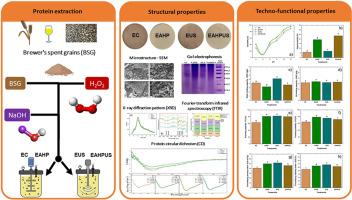Extraction of proteins from brewer's spent grain using ultrasound and alkaline hydrogen peroxide: Impact on extraction yield, structural and techno-functional properties
IF 11
1区 农林科学
Q1 CHEMISTRY, APPLIED
引用次数: 0
Abstract
BSG (brewer's spent grain) is an abundant agro-industrial by-product and a potential low-cost sustainable source of proteins. In this study, we evaluated the use of high-intensity ultrasound (US) and/or alkaline hydrogen peroxide (AHP) to improve the protein extraction process, as well as the structural and technical-functional properties of the obtained proteins. Four extraction processes were evaluated: EC - extraction using the conventional method; EAHP - extraction using alkaline hydrogen peroxide (3 %); EUS - ultrasound extraction (1200 W); EAHPUS -extraction using AHP (3 %) and US (1200 W). EAHP, EUS, and EAHPUS caused structural changes in the BSG, resulting in higher protein extraction yield compared to EC (69.6–139.6 %). Structural analyses (SEM, FTIR, CD, and X-ray diffraction) showed that the EAHP, EUS, and EAHPUS concentrates exhibited particle fragmentation, changes in the secondary structures of proteins, an increase in disordered structures (random coil), and a reduction in the size of crystals. Each extraction method influenced differently the techno-functional properties. EUS improved the water-holding capacity (∼24 %) and did not affect the color of the extracted proteins, whereas EAHP and EAHPUS reduced the water-holding capacity (11.50–22.05 %), increased solubility (3.22–46.66 % depending on pH), and caused a noticeable change in color. Compared with EC, all treatments improved the foaming capacity (28.05–31.06 %) and stability (11.48–22.19 %), emulsifying capacity (13.66–27.60 %) and stability (16.07–26.12 %), while no effect was observed on the oil-holding capacity. Therefore, the results highlight the potential of using ultrasound and/or alkaline hydrogen peroxide to improve the extraction of BSG proteins, although the effects on techno-functional properties must be considered for different applications.

超声波和碱性过氧化氢从啤酒废粮中提取蛋白质:对提取率、结构和技术功能特性的影响
啤酒废粮是一种丰富的农业工业副产品,也是一种潜在的低成本可持续蛋白质来源。在这项研究中,我们评估了使用高强度超声(US)和/或碱性过氧化氢(AHP)来改善蛋白质提取过程,以及所获得蛋白质的结构和技术功能特性。对四种提取工艺进行了评价:EC -传统提取法;碱性过氧化氢(3%)萃取EAHP法;EUS -超声提取(1200w);用AHP(3%)和US (1200 W)提取EAHPUS。EAHP, EUS和EAHPUS引起BSG结构变化,导致与EC相比更高的蛋白质提取率(69.6 - 139.6%)。结构分析(SEM, FTIR, CD和x射线衍射)表明,EAHP, EUS和EAHPUS浓缩物表现出颗粒破碎,蛋白质二级结构改变,无序结构(随机线圈)增加,晶体尺寸减小。不同提取方法对其工艺功能性质的影响不同。EUS提高了保水能力(~ 24%),不影响提取的蛋白质的颜色,而EAHP和EAHPUS降低了保水能力(11.50 - 22.05%),增加了溶解度(3.22 - 46.66%,取决于pH值),并引起了明显的颜色变化。与EC相比,各处理均提高了泡沫容量(28.05 ~ 31.06%)和稳定性(11.48 ~ 22.19%),乳化容量(13.66 ~ 27.60%)和稳定性(16.07 ~ 26.12%),但对保油能力无影响。因此,该结果强调了使用超声波和/或碱性过氧化氢来改善BSG蛋白提取的潜力,尽管必须考虑不同应用对技术功能特性的影响。
本文章由计算机程序翻译,如有差异,请以英文原文为准。
求助全文
约1分钟内获得全文
求助全文
来源期刊

Food Hydrocolloids
工程技术-食品科技
CiteScore
19.90
自引率
14.00%
发文量
871
审稿时长
37 days
期刊介绍:
Food Hydrocolloids publishes original and innovative research focused on the characterization, functional properties, and applications of hydrocolloid materials used in food products. These hydrocolloids, defined as polysaccharides and proteins of commercial importance, are added to control aspects such as texture, stability, rheology, and sensory properties. The research's primary emphasis should be on the hydrocolloids themselves, with thorough descriptions of their source, nature, and physicochemical characteristics. Manuscripts are expected to clearly outline specific aims and objectives, include a fundamental discussion of research findings at the molecular level, and address the significance of the results. Studies on hydrocolloids in complex formulations should concentrate on their overall properties and mechanisms of action, while simple formulation development studies may not be considered for publication.
The main areas of interest are:
-Chemical and physicochemical characterisation
Thermal properties including glass transitions and conformational changes-
Rheological properties including viscosity, viscoelastic properties and gelation behaviour-
The influence on organoleptic properties-
Interfacial properties including stabilisation of dispersions, emulsions and foams-
Film forming properties with application to edible films and active packaging-
Encapsulation and controlled release of active compounds-
The influence on health including their role as dietary fibre-
Manipulation of hydrocolloid structure and functionality through chemical, biochemical and physical processes-
New hydrocolloids and hydrocolloid sources of commercial potential.
The Journal also publishes Review articles that provide an overview of the latest developments in topics of specific interest to researchers in this field of activity.
 求助内容:
求助内容: 应助结果提醒方式:
应助结果提醒方式:


